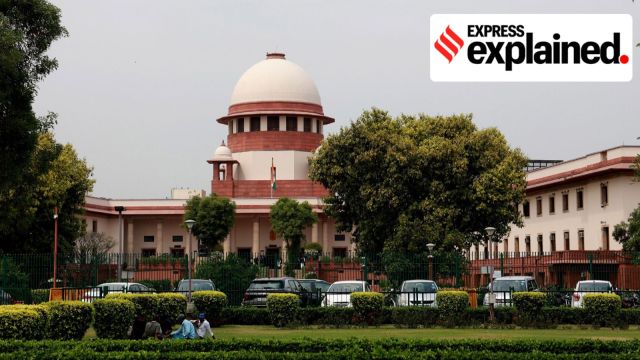Apex court rules states can sub-classify SCs and STs for quota: Tribal and Dalit communities that may be affected
The Supreme Court said, 'The State in exercise of its power under Articles 15 and 16 is free to identify the different degrees of social backwardness and provide special provisions (such as reservation) to achieve the specific degree of harm identified.'
 The majority verdict by Chief Justice of India D Y Chandrachud and Justices B R Gavai, Vikram Nath, Pankaj Mithal, Satish Chandra Sharma and Manoj Misra overruled the 2004 judgement in E V Chinnaiah vs State of Andhra Pradesh. (File Photo - Amit Mehra)
The majority verdict by Chief Justice of India D Y Chandrachud and Justices B R Gavai, Vikram Nath, Pankaj Mithal, Satish Chandra Sharma and Manoj Misra overruled the 2004 judgement in E V Chinnaiah vs State of Andhra Pradesh. (File Photo - Amit Mehra)On Thursday, the Supreme Court ruled that Scheduled Castes do not constitute a socially homogeneous class, and can be sub-classified by states for the purpose of providing reservation to the less privileged among them.
The majority opinion said, “The State in exercise of its power under Articles 15 and 16 is free to identify the different degrees of social backwardness and provide special provisions (such as reservation) to achieve the specific degree of harm identified.”
Here is a look at some prominent tribal and Dalit communities in 10 states of India who may be affected by Thursday’s
MAHARASHTRA
More than three dozen SC communities; Mahar and Matang are most prominent. Mahar are socio-politically proactive, with comparatively high literacy. Indian Army has a Mahar Regiment. Large numbers followed Dr BR Ambedkar in embracing Buddhism in 1956. Matang are the second largest SC community; majority are Hindu.
Gond, who live in Vidarbha, especially in Gadchiroli and Chandrapur districts, and Bhil, who are concentrated in North Maharashtra districts of Nandurbar, Nashik, and Dhule, are two largest tribes.
RAJASTHAN
59 SCs in State List; Meghwal is largest SC community, spread across the state, but mainly in border districts of Bikaner, Jaisalmer, Barmer, Jodhpur. Bairwa and Jatav are dominant in eastern Rajasthan.
Meena are most dominant tribe; influence electoral outcome in dozens of Assembly seats. Community has significant presence in police and bureaucracy countrywide. Bhil, some of whom do not consider themselves Hindu, are dominant in Banswara and Dungarpur districts, and have of late rallied behind a new tribal party.
ODISHA
Tribals are 22.85% of state’s population and 9.17% to India’s tribal population (2011 Census). State has 62 tribes and 13 other primitive tribes. Khond are numerically largest; live mostly in southern Odisha districts of Rayagada, Kandhamal, Kalahandi, Koraput. Santal are second largest tribal group, followed by Gond.
93 SCs in state; 17.13% of total population (2011). Pan are dominant SC community, followed by Dom. Other SC communities include Dhoba, Ganda, Kandra, Bauri.
CHHATTISGARH
STs are more than 30% of state’s 2.55 crore population (2011). Gond are most dominant of the 43 tribal communities; constitute almost 55% of tribal population. Kawar/ Kanwar (more than 11%) and Oraon (almost 10%) people are next.
As per the 2011 Census, 44 SC groups make up 12.7% of state’s population. Largest group among the SCs constitutes more than 70% of the Dalit population, and is known by 16 different names, such as Bairwa, Raidas, etc.
MADHYA PRADESH
SCs are about 15.6% of state’s population. Members of the largest Dalit group, which makes up more than 47% of the SC community’s numbers, were traditionally leather workers and live across the state. The Balai, who live in the Malwa region, constitute about 12% of the state’s SC population (2011).
STs are 21% of the population. The Bhil are the largest community, making up more than 39% of the tribal population. The Gond are the other large community, approximately a third of the state’s ST population.
WEST BENGAL
Rajbanshi are largest SC group, comprising more than 18% of state’s 21.4 million SCs (2011); can influence electoral outcomes in 20 Assembly seats in North Bengal. Matua are now the second largest SC group; they are mostly concentrated in North and South 24-Parganas, and in border districts like Nadia, Howrah, Cooch Behar, North and South Dinajpur and Malda.
The Matua religion was founded by Harichand Thakur in the 19th century, who worked among the “untouchables”. The third largest SC community are the Bagdi, who live mainly in Bankura and Birbhum.
GUJARAT
27 Dalit castes; Vankar, whose traditional occupation is weaving, make up around 35-40% of SC population in state, and lead other Dalit communities in education and jobs. Rohit, who are around 25-30% of the SC population, are the next most dominant SC community.
Bhil constitute almost 43% of the tribal population, and live mainly in the districts of Dang, Panchmahal, Bharuch, Banaskantha and Sabarkantha. Halpati, who live mainly in the southern districts of Surat, Navsari, Bharuch, and Valsad, constitute more than 6% of state’s tribals.
ASSAM
Tribal population is 12.4% of total population (2011 Census). Fifteen recognized tribes in autonomous districts of Karbi Anglong and North Cachar Hills; 14 in rest of the state. Bodo are the largest tribe (35.1% of the tribal population) and politically most powerful. Karbi are the largest hill tribe and third largest tribe in state (11.1% of tribal population).
TRIPURA
19 recognised tribal communities make up more than 30% of state’s population. Ancient Tripuri clan includes the Debbarma community, the erstwhile ruling dynasty of Tripura. There are 34 SCs in state, who make up almost 18% of the population (2011). SCs include the Das, Badyakar, Shabdakar, Sarkar, etc communities.
UTTARAKHAND
Thakur and Brahmin are around 55% of the population; OBC are about 18%, and SCs and STs together are just about 22% (2011). Harijan and Balmiki, both of whom follow Hindu religious practices, are the largest SC groups. The Jaunsari and Tharu are the two largest ST groups in the state.






































